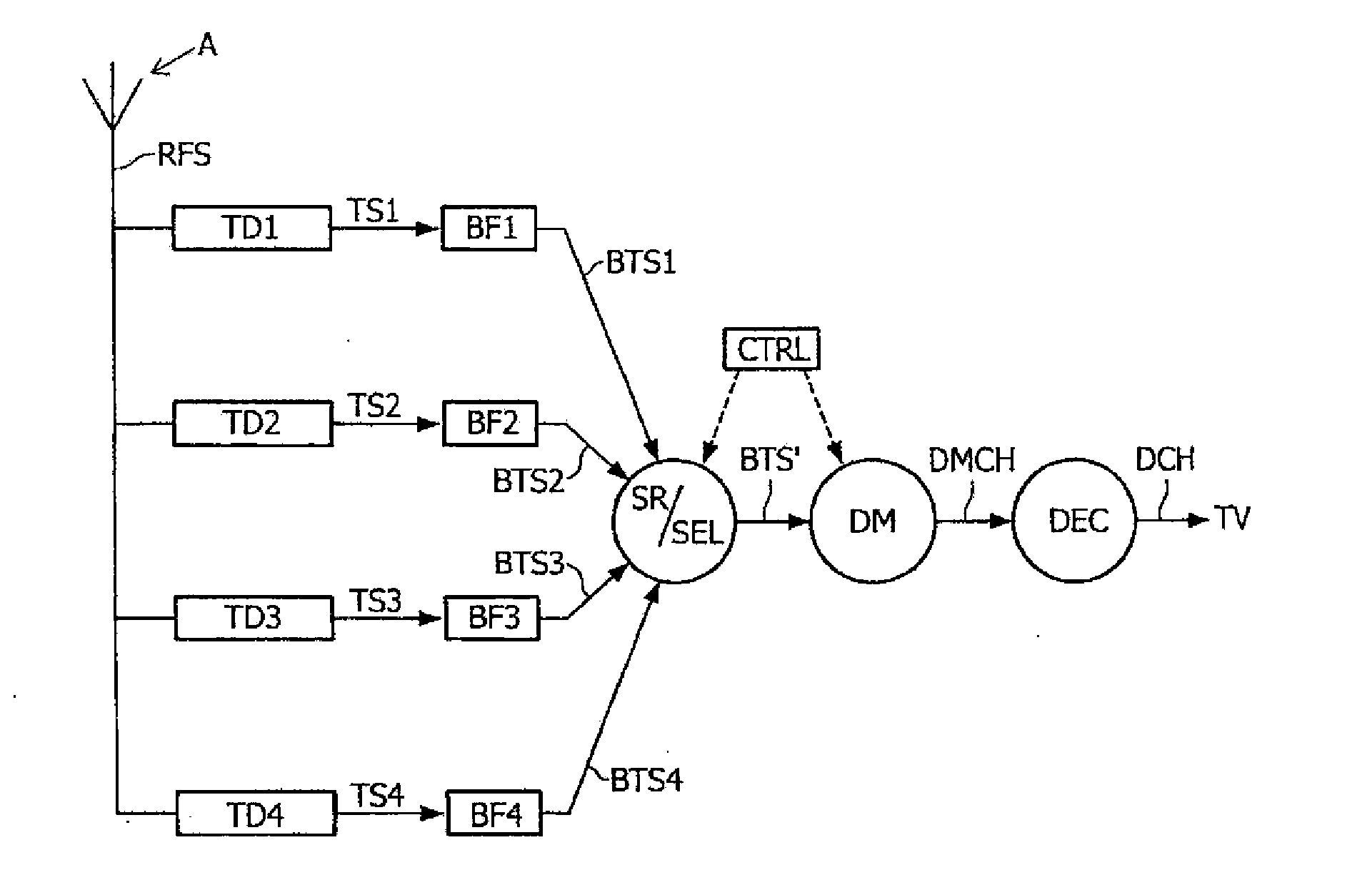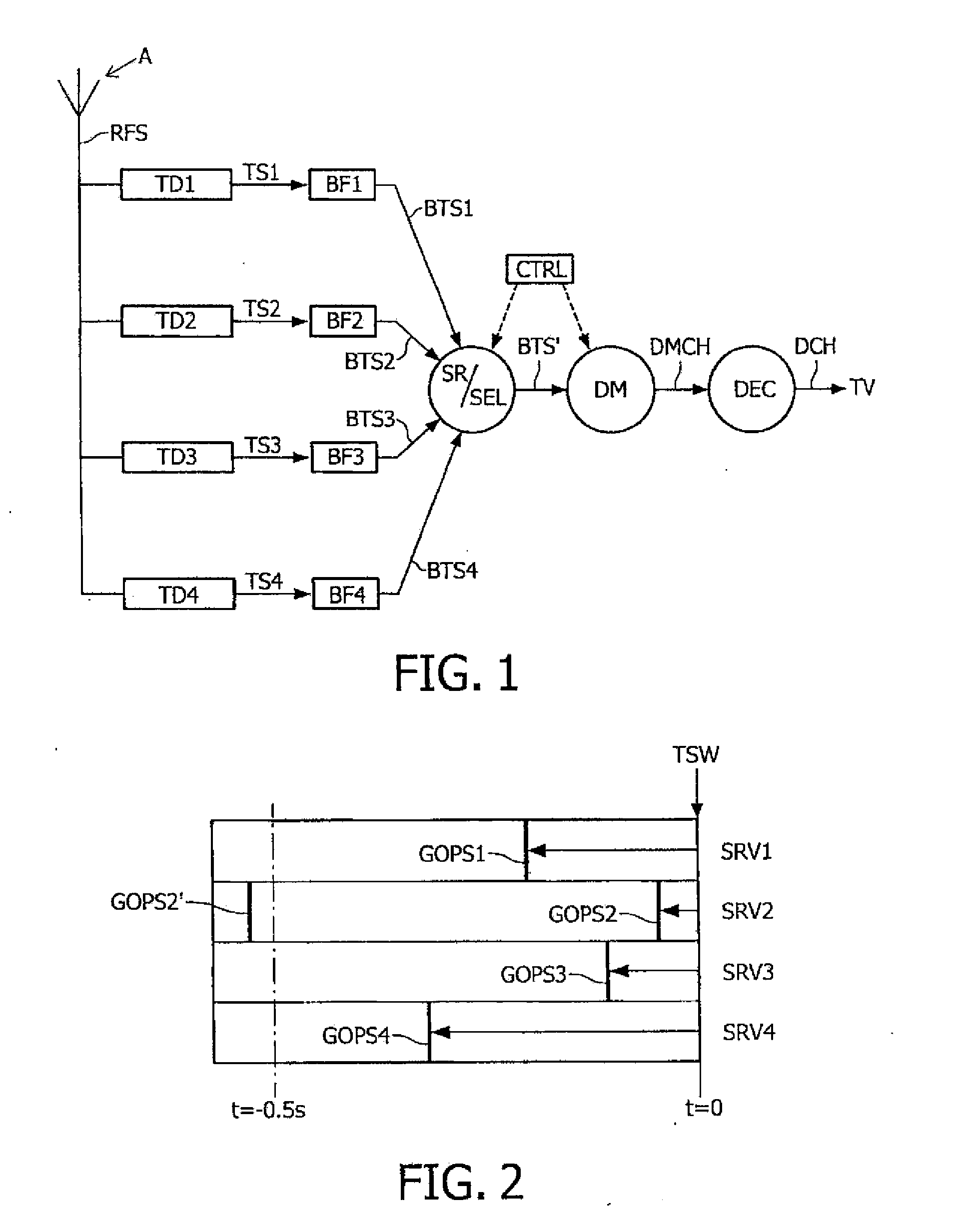Fast Channel Switch Between Digital Television Channels
a digital television channel and channel switch technology, applied in the direction of color television with bandwidth reduction, selective content distribution, television systems, etc., can solve the problems of large software and/or system complexity, time it takes to switch from one channel to another channel, and large buffering requirements, so as to reduce the number of buffers.
- Summary
- Abstract
- Description
- Claims
- Application Information
AI Technical Summary
Benefits of technology
Problems solved by technology
Method used
Image
Examples
first embodiment
[0115]FIG. 1 shows a system in accordance with the invention. The system comprises an antenna A configured for receiving an RF modulated signal. In an alternative embodiment the antenna may be an antenna cable (which may be shared between different houses or buildings). The RF modulated signal is fed into four respective tuner / demodulator units TD1, TD2, TD3, TD4. This number of tuner / demodulator units is used throughout all examples in this description. However, the invention is not limited to a specific number of tuner / demodulator units. Any number equal to or larger than 1 is possible. In general more tuner / demodulator units features receiving more transport streams in parallel. For the invention this means that more channels benefit from fast-zapping feature between channels. Each tuner / demodulator unit is preferably tuned to a particular one of available frequency bands, each band comprising a plurality of channels or services in a single transport stream. Typically one such fr...
second embodiment
[0140]FIG. 3 shows a system in accordance with the invention. This figure will be discussed in as far as it differs from FIG. 1. A first difference is that a control signal CI (for example using an I2C interface) has been illustrated from the controller CTRL to the respective tuner / demodulator units TD1, TD2, TD3, TD4. The control interface / control signal CI from the controller to the tuner / demodulator units TD1, TD2, TD3, TD4 serves to tune in the respective tuners on a specific frequency band. After tuning in of the tuners no further control of the tuner / demodulator units is required. FIG. 3 further shows four channel decoders CHDEC that are coupled to a special source decoder SSDEC, each channel decoder comprising a respective one of the earlier mentioned tuner / demodulator units TD1, TD2, TD3, TD4. The channel decoders (i.e. tuner / demodulators) produce transport streams TS1, TS2, TS3, TS4. The buffering is done in the special source decoder SSDEC. To this end the special source d...
third embodiment
[0141]FIG. 4 shows a system in accordance with the invention. This figure will be discussed in as far as it differs from FIG. 3. FIG. 4 also shows four channel decoders that are coupled to a (less) special source decoder SSDEC′ without the buffers. However, in this embodiment the transport stream buffers BF1, BF2, BF3, BF4 are integrated in the channel decoders instead of the source decoder, which makes each respective combination TDB1, TDB2, TDB3, TDB4 of tuner / demodulator and transport stream buffer a special channel decoder SCHDEC. In this embodiment an additional command is added to the control interface CI (e.g. I2C bus) between source decoder SSDEC′ and channel decoder SCHDEC: the source decoder SSDEC′ can request the channel decoder SCHDEC to start streaming its currently received multiplex for a particular service (i.e. TV program). This service is preferably identified by the PIDs of its elementary streams. The source decoder SSDEC′ can maintain an up-to-date mapping from s...
PUM
 Login to View More
Login to View More Abstract
Description
Claims
Application Information
 Login to View More
Login to View More - R&D
- Intellectual Property
- Life Sciences
- Materials
- Tech Scout
- Unparalleled Data Quality
- Higher Quality Content
- 60% Fewer Hallucinations
Browse by: Latest US Patents, China's latest patents, Technical Efficacy Thesaurus, Application Domain, Technology Topic, Popular Technical Reports.
© 2025 PatSnap. All rights reserved.Legal|Privacy policy|Modern Slavery Act Transparency Statement|Sitemap|About US| Contact US: help@patsnap.com



